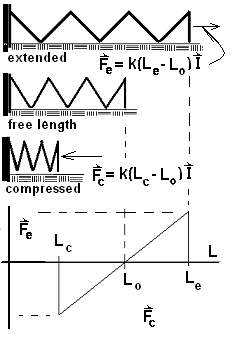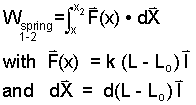| THERMO Spoken Here! ~ J. Pohl © | TOC NEXT ~ 173 |
3.24 Simple Springs
There are hundreds of varieties of springs. Our development will apply in general but will be made in terms of an ideal coiled spring. In elementary design, the kinetic energy and potential energy of a spring are taken to equal zero and since high temperatures destroy a spring, their events are assumed adiabatic or nearly so. The work is intrinsic, the energy equation is simply:

| (1) 1 |
Coil springs are built with a free or unloaded length which we label Lo. The "displacement" of a coil spring corresponds to a change of its length which can happen in a number of ways. An example might be that a spring is stretched then stretched more, or compressed then allowed to extend. All possibilities can be built into an equation by expressing the spring displacement as: L - L0

Displacement of an ideal spring requires a force magnitude which is linearly proportional to its displacement,
| |Fspring| = k |(L - L0)| | (2) 2 |
The experimentally determined proportionality constant, k, is called the spring constant.
The sketch shows a coil spring with its left end immovably attached. The spring can move without friction on the horizontal plane. Its length without load is Lo. For the spring to be extended, the force must be directed to the right, positive I direction, and the displacement will also be positive. Such work is positive and is reflected by an increase of internal energy of the spring. The magnitude of the force increases in linear proportion to the distance of extension. Conversely, to compress the spring from the initial length, L = Lo requires a negative force that acts through a negative displacement and the spring internal energy increases again. General integration determination of spring work is as follows.

| (3) |
Confusion with signs is avoided by keeping the reference, the free length, Lo, in the equation.

| (4) 4 |
When a spring is part of the system, its change of internal energy effects the event. A spring as surroundings can effect an event by the mechanism of work.